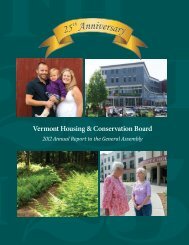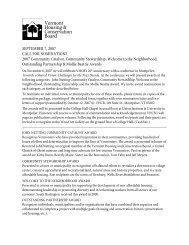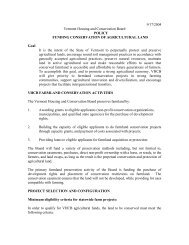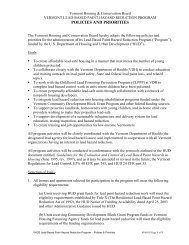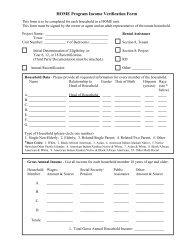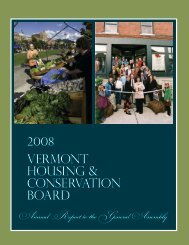Vermont Housing Conservation Board 2005 - Vermont Housing and ...
Vermont Housing Conservation Board 2005 - Vermont Housing and ...
Vermont Housing Conservation Board 2005 - Vermont Housing and ...
You also want an ePaper? Increase the reach of your titles
YUMPU automatically turns print PDFs into web optimized ePapers that Google loves.
36<br />
AMERICAN PRECISION MUSEUM, WINDSOR<br />
Birthplace of Modern Manufacturing is Reborn<br />
The American Precision Museum in Windsor is more than a treasure trove<br />
of manufacturing machinery. It was in this 1840s-vintage brick building<br />
that modern consumer society was born.<br />
Not enough <strong>Vermont</strong>ers or others know the local l<strong>and</strong>mark’s remarkable<br />
story. Now, thanks to the devotion of the nonprofit board of trustees that<br />
runs the Precision Museum, coupled with funding from VHCB, a federal Save<br />
America’s Treasures partnership, <strong>and</strong> other sources, the museum is being saved<br />
for new generations to explore. Last year, more than 5,000 people visited this<br />
new center for the collection, preservation <strong>and</strong> interpretation of the history of<br />
precision manufacturing.<br />
“I’ve always seen that building as a special place,” says Eric Gilbertson, the<br />
deputy state historic-preservation officer <strong>and</strong> a Precision Museum trustee. “It’s<br />
the most intact example of early to mid-19th century mill building in <strong>Vermont</strong>,<br />
particularly of that scale. And what went on inside the building is so important.”<br />
The tall brick structure sits at the southern end of Windsor’s downtown,<br />
slightly below modern road level, beside a tumbling-water stretch of the Mill<br />
Brook. It was here in the late 1840s, inside what was then called the Robbins &<br />
Lawrence Armory <strong>and</strong> Machine Shop, that skilled machinists <strong>and</strong> designers created<br />
a set of finely engineered machine tools to turn out military rifles made of<br />
interchangeable parts. That manufacturing advance was br<strong>and</strong> new to the world.<br />
Before the Robbins & Lawrence innovation, a gunsmith needed eight days to<br />
make one rifle, crafting each individual part in turn. This was the way all mechanical<br />
devices were made. Then, in 1851, the local gunmakers Robbins, Kendall<br />
<strong>and</strong> Lawrence brought a batch of new Windsor-built rifles to London’s Crystal<br />
Palace Exposition. They took the guns apart, mixed all the parts together on the<br />
exposition floor, then reassembled new guns. The British Army quickly ordered<br />
25,000 Enfield rifles <strong>and</strong> 138 gun-making machines — <strong>and</strong> thereby imported to<br />
“I’ve always seen<br />
that building as a<br />
special place. It’s the<br />
most intact example<br />
of early to mid-<br />
19th century mill<br />
building in <strong>Vermont</strong>,<br />
particularly of that<br />
scale. And what went<br />
on inside the building<br />
is so important.”<br />
—Eric Gilbertson,<br />
deputy state historic<br />
preservation officer &<br />
museum trustee



